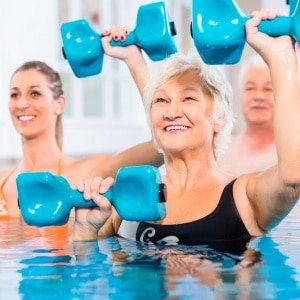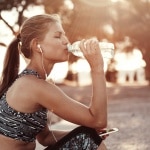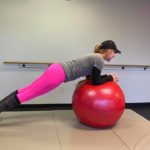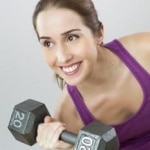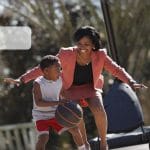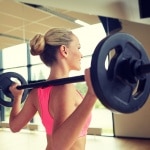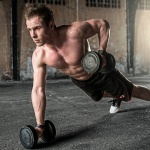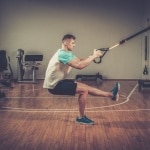 August 2022
August 2022
Single-Leg Squat: A Tried & True Exercise for Life
It’s rare that we promote any one exercise for any and all people, but some things just make sense. Other than sitting or standing still, invariably we live on one leg at a time. Therefore it makes sense to perform some lower body exercises that shift our weight onto one leg, entirely or in part. Not only does this enhance strength, and reduce the amount of extra loading necessary to do so (think: no barbell necessary), it also challenges balance.
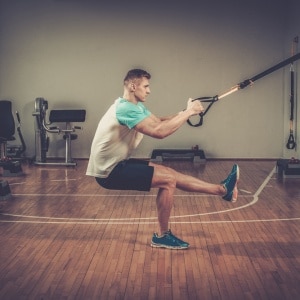
But, until recently, no one has gaged which position the free leg should be in to get benefits to which muscles in the single-leg squat (SLS.) This is important, not just for the athlete or the rehab process; it is informative for those who wish to optimize the benefits of this already very demanding exercise.
A study compared the muscle activation of 3 SLS: one with the free leg in front (SLS-F), in back (SLS-B), or neutral (SLS-N.) Traditionally, the SLS-F is done with the trunk in an upright posture to counter the weight of the forward leg. The SLS-B is done with the body tipped slightly forward to counterbalance the free leg behind you. And the SLS-N is done upright or slightly flexed.
They found that the SLS-F actually engaged more gluteus maximus/buttocks muscle than the SLS-B, despite expectations otherwise. While their explanation as to why this was so was questionable, it raised other concerns for the training community. For example, the SLS-F also allowed more hip internal rotation which is not a favorable occurrence as far as knee safety is concerned.
Thus, the overall conclusion was that the SLS-N might be the best way to do this exercise. And, while working all the same muscles as the other two, might also be the safest and easiest to do on your own.
J Athletic Training Feb. 2022
Training vs De-Training in Older Women: Never Stop!
As you might expect, when it comes to fitness, either use it or lose it. But as we age, that decline into less strength, power, endurance, and function is harder to gain and easier to lose.
A Brazilian study assessed the strength, power, and functional capacity (FC = Senior Fitness Test: 30-sec. arm curl, 30-sec. chair sit-stand, back scratch, chair sit and reach, 8’ get up and go, and 6-minute walk tests) in 5 resistance training (RT) groups of older women: strength-endurance (high-reps, low-loads), power (high loads, fast lifts, low reps), absolute strength (high loads, high sets), and traditional strength (2-3 sets of varying rep ranges), plus a control group. The study consisted of 20 weeks of RT and 4 weeks of detraining. All training groups did the same 6 exercises twice a week under supervision.
As expected, all the RT groups improved in all the test variables of strength, power, endurance, and FC. The CG did not improve in any variable. The absolute RT group had more pronounced strength gains compared to the traditional RT. The power trainees stood out in their gains of power compared to the other RT groups. After 4 weeks of detraining, again, as expected, the RT groups lost a lot of their gains but FC – remember, their performance on the Senior Fitness Test variables – though reduced was “maintained at higher levels in comparison to [their] baseline.”
What’s notable is that the power and absolute RT groups lifted heavier loads and, in the case of the power trainees, faster lifts.
The authors conclude by suggesting that older women can get long-lasting benefits from faster and heavier lifting that will last longer in the event you have to take some time off.
JSCR Apr. 2022
Tid Bits
A small study demonstrated that a “single injection of LR-PRP (leukocyte-rich platelet rich plasma) into the knee does significantly improve functional mobility, pain, and quality of life at six weeks,” according to the lead author. This assessment was based on the timed get-up-and-go test as well as high-tech wearable technology to assess activity levels, plus patient-reported measures. From a study in Regenerative Medicine, reviewed in Training & Conditioning Sept. 2021
Chronic non-specific low back pain (NSLBP) is endemic: nearly 80% of Americans will experience it at some point though most will recover fully within 3 months. A meta-analysis determined that walking/running yielded better pain management than no interventions but not as good as alternative treatments. Likewise, there’s not enough evidence showing benefits to swimming or cycling despite anecdotal reports of them being useful. Aquatic exercise, which differs from swimming, has been shown to reduce pain and improve function in those with NSLBP. JOSPT Jan. 2022
There’s some evidence that shows excessive volumes or intensities of exercise may contribute to scarring of coronary arteries that show up as coronary artery calcium (CAC) which is associated with risk of future cardiovascular complications. A review of a large, diverse data pool of Americans over a 15 year span found that, contrary to the hypothesis that heavy exercise might increase risk of vascular disease, “participants with high CAC that engaged in the highest quartile of physical activity had a reduced risk of mortality, and no increased risk of cardiovascular disease.” This was true regardless of race, gender, or even CAC levels, and despite any other “traditional risk factors” like hypertension, etc. In sum, high amounts of physical activity appear to be safe even for those at high risk of heart disease. MSSE May 2022

